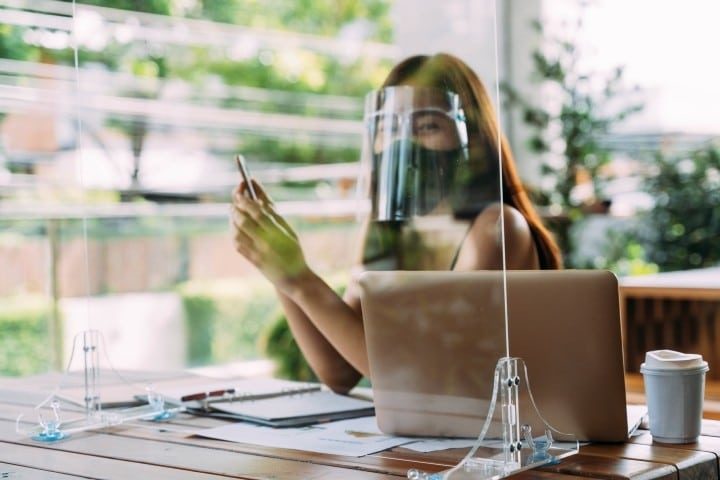
All those plastic screens that have been erected to stop the spread of COVID-19 are useless and may even make viral transmission more likely, the New York Times reported Thursday.
Businesses and schools hastily put up the clear barriers last year at the urging of so-called public-health experts such as the bureaucrats at the Centers for Disease Control and Prevention (CDC). The barriers were supposed to prevent the coronavirus from being transmitted from person to person by blocking tiny, virus-laden particles exhaled by infected individuals from entering others’ airspace.
The idea sounds reasonable enough, but then so do social distancing and masking, both of which have turned out to be far less helpful than advertised. In fact, masks may also do more harm than good.
The concept of germ-proof barriers, however, runs smack into the laws of physics. Unless people are completely enclosed in such barriers, air can still get around them; and eventually it, and the particles it carries, will. Furthermore, by changing the airflow pattern in a space, the barriers may redirect the particles to other people and even concentrate those particles in their space, making them more likely to contract COVID-19 than they otherwise would be.
The Times explains:
Under normal conditions in stores, classrooms and offices, exhaled breath particles disperse, carried by air currents and, depending on the ventilation system, are replaced by fresh air roughly every 15 to 30 minutes. But erecting plastic barriers can change air flow in a room, disrupt normal ventilation and create “dead zones,” where viral aerosol particles can build up and become highly concentrated.
“If you have a forest of barriers in a classroom, it’s going to interfere with proper ventilation of that room,” said Linsey Marr, professor of civil and environmental engineering at Virginia Tech and one of the world’s leading experts on viral transmission. “Everybody’s aerosols are going to be trapped and stuck there and building up, and they will end up spreading beyond your own desk.”
As is often the case with government-recommended policies, barrier erection tackles a visible problem without considering the invisible side effects. Yes, barriers will stop large droplets that are spewed when someone coughs or sneezes; but they won’t do a thing to prevent the distribution of the aerosol particles that are emitted when a person speaks.
“One way to think about plastic barriers is that they are good for blocking things like spitballs but ineffective for things like cigarette smoke,” Marr said. “The smoke simply drifts around them, so they will give the person on the other side a little more time before being exposed to the smoke. Meanwhile, people on the same side with the smoker will be exposed to more smoke, since the barriers trap it on that side until it has a chance to mix throughout the space.”
In a classroom with barriers around each desk, the problem could even be worse. “If there are aerosol particles in the classroom air, those shields around students won’t protect them,” Richard Corsi, incoming dean of engineering at the University of California, Davis, told the Times. “Depending on the air flow conditions in the room, you can get a downdraft into those little spaces that you’re now confined in and cause particles to concentrate in your space.”
The newspaper cited several studies showing that the barriers were useless or worse, some of which were conducted well before the “experts” declared plastic screens to be one of the solutions to the pandemic. Several recent studies, for example, found that barriers in schools impede airflow and either make no difference in or increase the likelihood of COVID-19 transmission. A 2013 study of partitions between hospital beds concluded that “while some people were protected from germs, the partitions funneled the air in the room toward others,” and a 2014 study “found that office cubicle dividers were among the factors that may have contributed to disease transmission during a tuberculosis outbreak in Australia.”
Other than the commonsense suggestion that people who feel sick should stay home, practically every COVID-19 mitigation measure our supposed experts have recommended — and that includes the vaccines — has been found wanting. Why should we trust them when it comes to anything else?



